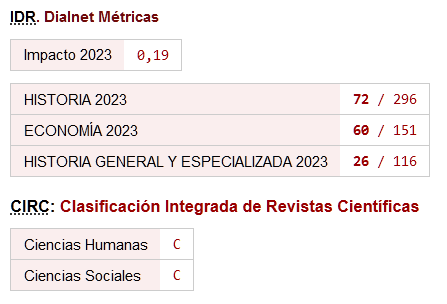Financial information at the service of image. Financial statements of the spanish bank of San Fernando and its succeeding the Bank of Spain, in the previous stage to the privilege of issuing bank (1847-1873)
DOI:
https://doi.org/10.26784/issn.1886-1881.v5i9.152Keywords:
Accounting history of banking, Spanish Bank of San Fernando - Bank of Spain, Reputational risk and financial statements, 19 th centuryAbstract
The Spanish Bank of San Fernando created in 1847, as result of a merge, presented important losses, which were corrected in the last six years of its life. The change of denomination in 1856 adopting the name of Bank of Spain, did not suppose any real variation, because it kept its activity in all significant aspects.
In 1856, the Spanish banking system was radically transformed. The possibility to create local issuing banks was opened, as well as a new type of banking entities, the Credit Societies, similar to the present private banks. All of this enabled competition. Later, many of these institutions failed as a consequence of the crisis of all type that our country underwent in the period examined.
A series of extraordinary facts and circumstances deteriorated as much the public image of the Spanish Bank of San Fernando that it was brought at bankruptcy’s door. Apart from the financial solutions adopted to solve its capital problems, other measures were taken in order to protect its reputation. Among other measures, it was decided to reduce to the minimum the information provided on the Institution situation and its activities. In this sense, the General Meeting of Shareholders was not convened during three years (1848-1851). When the critical situation was overcome, the normality returned and the General Meetings of Shareholders were regularly held and the information reached progressively a normal level.
The analysis is extended until 1873, just before the Bank of Spain became, in a definitive and permanent manner, the only Spanish issuing bank. It was endowed with an extensive national branches net, had a sound solvency, and new operative activities. In any case, it always remained at the service of the State, its principal debtor. To reach such position it had to overcome some moments certainly hazardous.
The aim of this paper is to explain how, after its fall, the reputation of the Bank, this great intangible good, could be reconstructed. This purpose is pursued above all through the examination of the financial statements published in the Annual Report. Thanks to the analysis of the qualitative image transmitted by them,
and its comparison to the real situation of the Entity, in many moments not known by the public opinion, we were able to get an idea of the scene. This was properly so because the information provided by the Annual Reports permitted an analysis far beyond the purely numerical data. Thus by the simple reading of the statements and the study of their evolution, we could obtain material to accomplish our qualitative analysis, quite different from the examination of the purely countable or legal aspects as those and also later times was the use.
In the present world, with the financial statements normalization, this kind of analysis could, in general, not be done. In any case, the image of the entity transmitted by the Annual Reports is subject of careful study, because corporations are fully conscious that it is a basic component of their reputation.
Downloads
References
Banco de San Carlos (1785): Memoria de la 4ª Junta General del Banco Nacional de San Carlos celebrada en la casa del mismo Banco en 29 de Diciembre 1785. Imprenta de la Viuda de Ibarra, Hijos y Compañía. Madrid.
Banco Español de San Fernando (1830-1832): Memoria de la 1ª Junta General del Banco Español de San Fernando de los años 1830, 1831, 1832, celebrada en su propio Establecimiento en 1º de Febrero de 1833. Impreso por D. E. Aguado, Impresor de Cámara de S.M. y su Real Casa en 1833. Madrid.
Banco Español de San Fernando (1845): Real Cédula de 9 de julio de 1829 para la erección del Banco Español de San Fernando y Reglamento del gobierno interior del Banco de igual fecha. Segunda edición. Imprenta y fundición de Don Eusebio Aguado. Madrid.
Banco Español de San Fernando (1846): Memoria.
Banco de Isabel II (1844): Real Decreto de 25 de enero de 1844 de creación del Banco; Estatutos y Reglamento interior de 1844. Editados por la Imprenta Nacional. Madrid.
Banco de Isabel II: Memorias desde su instalación hasta 31 de enero de 1845.
Nuevo Banco Español de San Fernando (1847): Real Decreto de Unión de los dos Bancos de 25 de febrero de 1847. En Memoria del Banco de 1847 (pp 38-40).
Nuevo Banco Español de San Fernando (1848): Estatutos aprobados por Real Orden de 22 de marzo de 1848. En Memoria del Banco de 1848 (p. 42-49).
Nuevo Banco Español de San Fernando (1852): Leyes orgánicas, Estatutos y Reglamento del Banco Español de San Fernando. Imprenta de Don José María Alonso. Madrid.
Nuevo Banco Español de San Fernando: Memorias desde 1847 a 1855.
Banco de España (1856): Leyes orgánicas, Estatutos y Reglamento del Banco de España. Aguado, impresor de cámara de S.M. y de su Casa Real. Madrid.
Banco de España (1867): Leyes orgánicas, Estatutos y Reglamento del Banco de España y sus Sucursales. Imprenta de Miguel Ginesta. Madrid.
Banco de España: Memorias desde 1856 a 1874.
Banco de España: Almanaque y Guía del Banco de España para 1893. Tip.Lit. del Banco de España. Madrid.
García López, A. (1999): Historia de la banca española a través de sus documentos. Lex Nova. Valladolid.
Gonzalo y González, L.(1981): El Tesoro Público y la Caja General de Depósitos (1852-1868). Instituto de Estudios fiscales. Madrid.
Hernández Esteve, E. (1989): "Apuntes para una historia de la contabilidad bancaria en España". Revista Española de Financiación y Contabilidad. Vol. XVIII, Nº 58, pp. 21-96.
Martínez Pérez, E. (1922): Banco de España, su régimen, operaciones, y situación. Graficas Reunidas. 2ª Edición. Madrid.
Pérez de Armiñan, G. (1983): Legislación bancaria española. Banco de España. 6ª Edición. Madrid.
Santillán, R. (1865a): Memoria histórica sobre los Bancos desde el Nacional de San Carlos hasta el de España. Tomo 1º. Establecimiento tipográfico de T. Fortanet. Madrid.
Santillán, R. (1865b): Memoria histórica sobre los Bancos desde el Nacional de San Carlos hasta el de España. Tomo 2º. Establecimiento tipográfico de T. Fortanet. Madrid.
Tedde de Lorca, P. (1988): El Banco de San Carlos (1782-1829). Alianza Editorial. Madrid.
Tedde de Lorca, P. (1999): El Banco de San Fernando (1829-1856). Alianza Editorial. Madrid.
Tortella Casares, G. (1970): "El Banco de España (1829-1929). La formación de un Banco Central", en obra colectiva El Banco de España. Una historia económica. Ferreira S.A. Artes Gráficas. Madrid.
Downloads
Published
How to Cite
Issue
Section
License
Copyright (c) 2023 Rafael Moreno Fernández

This work is licensed under a Creative Commons Attribution-NonCommercial-ShareAlike 4.0 International License.










